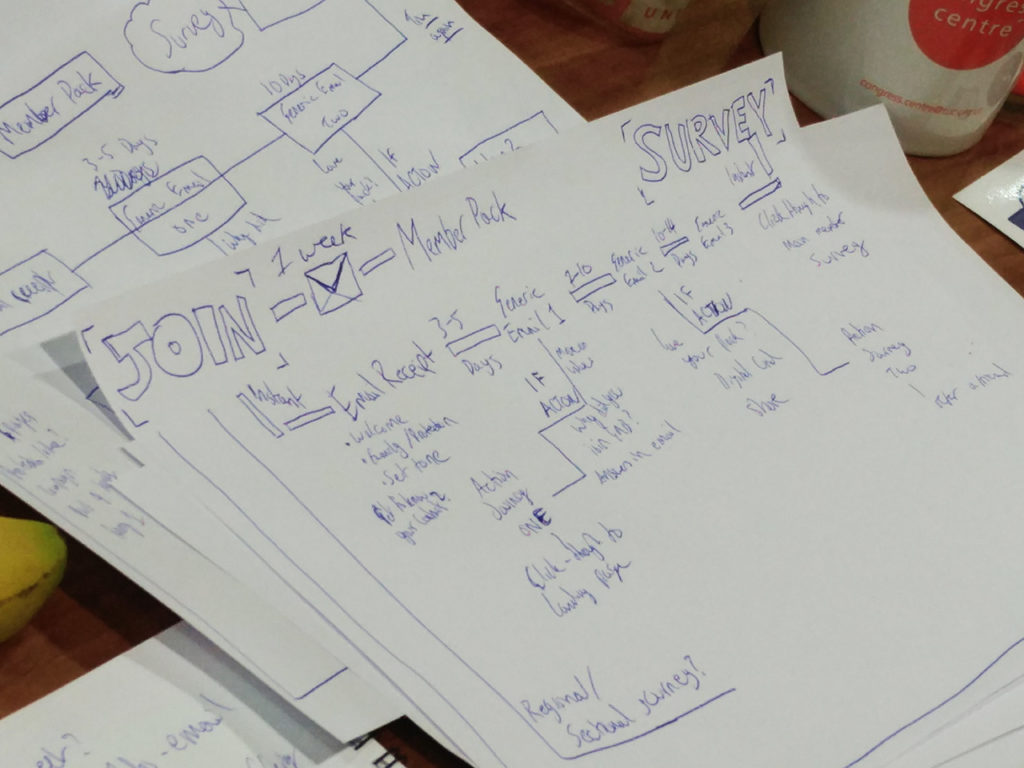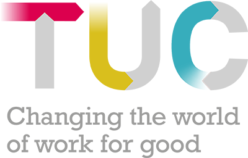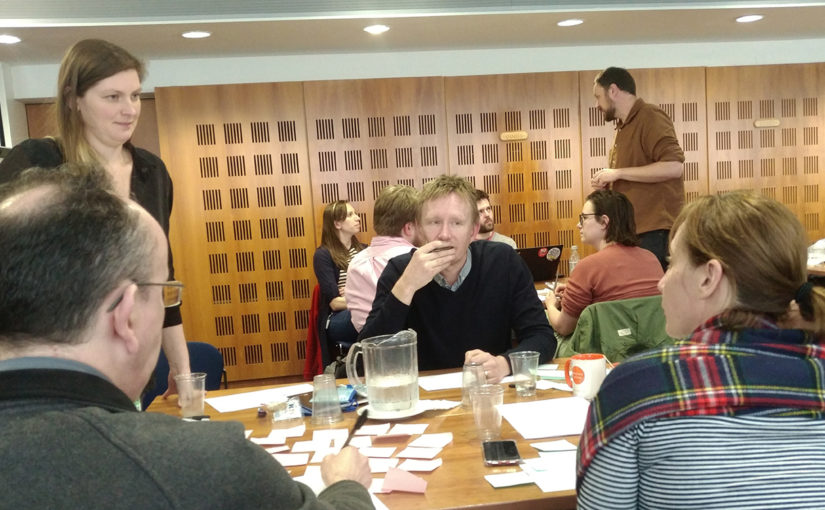The first TUC Digital Lab workshop (Friday 26th April) focused on using digital channels to welcome new members to our unions. Colleagues from different roles across 14 unions came together for a three hour deep-dive into the issue.
It was the first step in a new programme of workshops designed to explore new digital thinking and ways of working to better serve members across the movement (more about the TUC Digital Lab here).
What is ‘onboarding’?
The session opened with a short masterclass from Ali Walker Davies of Open. Using examples from charities and campaign groups, Ali ran through the four basic steps that underpin good practice in many charities’ use of email and social media in the first days and weeks of a relationship with a regular donor or supporter.
The central goal in these charitable supporter onboarding programmes is to overcome any sense of ‘buyer’s remorse’. A charity absolutely must avoid a new supporter signing up to give money then immediately cancelling their direct debit. Given the considerable cost and challenge of recruiting new supporters, it’s a huge loss for a charity if that supporter walks straight back out the door.
To counter this, Ali proposed that the key principles of an onboarding programme should be to:
- Make the new joiner feel welcomed
be genuinely and effusively appreciative and welcoming of a new member - Drive action
don’t be passive – find easy ways to get people engaged and doing things. - Start a conversation
listen and reflect – use the internet as an opportunity for a two-way dialogue - Show the impact
give examples of how you make a difference, and the supporter’s part in that
Ali illustrated how these principles could be worked into a ‘supporter journey’ that helps an organisation onboard a new supporter. Linking together a dedicated programme of initial messages, aimed specifically at new supporters formed a a journey, that could creatively help someone understand the ongoing work of the organisation, and see the value in their role as a supporter.
Supporter journeys in unions
With these principles and examples in mind, we then heard a union case study from Steph Izzard of Prospect’s digital comms team. Prospect are beginning to implement their own new member onboarding journey.
One thing that became apparent for Prospect was that, unlike the relationship between a charity and a regular donor, most (if not all) unions offer a range of services. The relationship is one of support and solidarity, but it’s also transactional. The member pays their subs and gets services and products in return.
This created some additional principles unions should consider:
- Give the new member the core information they need relevant to their own membership (e.g. their membership number and branch information)
- Help them understand the variety of services, products, offers and ways to get more involved in the union available to them.
Beyond increasing loyalty and retention of members by meeting their expectations (which are often set not by unions, but by the other products and services people use), unions can benefit further by using digital to reduce the cost of servicing members. Examples of this might include cutting postal costs as you replace new member packs with digital communications, or reducing the number of inbound enquiries your membership staff handle via phone or email.
Some important new stages of Prospect’s new member communications included:
- An immediate automatic email to new joiners that welcomes them and sets out some stages that they can expect. This buys the membership team a little time to complete the actual membership approval – something that isn’t an instant process and could otherwise slow down the journey. For a few people this may mean going back to them to follow up if the membership isn’t approved, but this is worth the improvement in immediate welcome for the vast majority.
- A welcome message from the General Secretary, helping new members understand him as a character and his role as a key concept in the organisation,
- A comprehensive digital guide to the union’s services. This is presented as an easy-to-find email referencing and linking to everything Prospect offers. The idea is that members keep this email rather than deleting it, so they have a quick reference for anything they need (and a constant reminder that their membership is a valuable thing).
In addition to these, the union is developing further ideas stretching from helping members with their annual review meetings, to digital membership cards stored in a mobile phone wallet, to listening for existing problems in the workplace, to a follow up survey (a year later) asking how the member has found their first year of membership and what the union can improve on.
The technical implementation of Prospect’s onboarding journey was quite simple. Their decision has been to use cheap, commodity technology (in their case Campaign Monitor, but MailChimp and many other services are similar) to ‘get started’, rather than wait for more complex technology integrations to unfold.
This means a certain amount of manual data work, as the membership database and Campaign Monitor aren’t currently connected to one another, in order to get the right data about new members into the correct segments and automated email lists. But it does mean they have been able to get going right away and observe the actual results of the programme, as opposed to waiting months or longer to see whether it works as hoped.
Working through the problem
The workshop then explored a number of questions to help them develop ideas for their own union’s welcome communications. Often it can be easy to jump straight into working on the content of interactions, but this can bring in assumptions, and lead you to missing good ideas.
We followed a four-step approach to understanding the problem:
1. Understanding new members and their needs
- Who are the new members joining our unions online?
- What is the context they are joining in? What has prompted them to join, and how do they think joining the union will help them? Does the medium through which they are joining us give them particular expectations or needs for how we work with them?
- What do we want them to feel in their first weeks and months? (‘Excited’, ‘Engaged’, ‘Supported’ and ‘Inspired’ were all popular adjectives, along with conveying the sense that union membership is active, not passive).
- How will you know whether the changes you are making will deliver against those user needs? What information would you need to demonstrate success, and how could you identify it, before and after the project?
2. Spotting the risks
- What should we avoid doing? What would put a new member off? Sometimes it’s a useful exercise to define what would be a bad outcome, to help us develop a good one.
- Answers we came up with included:
- being too transactional (only talking about the costs without the benefits)
- using inaccurate data in communications (it may be better to personalise less if you’re not sure you’re personalising them correctly)
- using union jargon that new members won’t understand (even concepts as core to our understanding as “the branch” will sound alien to people joining for the first time)
- depending on the particular union context and member motivations, either asking for too much activist involvement too quickly and scaring the member off, or failing to inspire people by not signposting enough meaningful ways to get active and realise their place in the union).

3. Mapping the journey
- What does the ‘journey’ of new membership look like? We started by sketching flow-chart style maps of the different stages. Each contact point was a box, connected by lines showing the order they appear in.
- What communications would a member ideally get, and at which moment?
- Which of them would be automatic steps that all members would see, and which might need to be tailored for people based on their interactions or situation?
- Which channels would be the best to deliver each stage of the journey? For some unions it might be more simple, for others, a multi-channel approach of email, SMS and social might be needed.
- What data and systems are involved? If we wanted to deliver the map as it stood, how would we do this?
- Do we have the right contact information or personalisation information in our systems? If not, what might we need to change in order to get it?
- Where the systems aren’t already in place to deliver this kind of journey, are there ways we could test some of these ideas with minimum viable solutions? Using an off-the-shelf tool temporarily, and agreeing to live with a degree of additional work in manual processes for a trial period may be an option.
- What processes and organisational factors do we need to consider?
- Welcoming a new member to the union could end up involving a number of stakeholders. How would we get their insights, and check that what we’re doing has value for them too?
- Relationships between different teams could also be a point to consider. How do we balance competing goals? How do we ensure we’re doing what has value to the member, rather than the internal goals of the union?
4. Defining the content
- What is the sequence of messages? Does our map still work? Constraints we’ve identified might change the possible order these interactions can come in.
- What’s the content of each message? Write a first draft of the messages to see if they make sense.
- Are you trying to get across too much in any single communication?
- Does the conversation make sense when read in that order?
- What tone do you need to use to deliver these messages? Who will they be sent from? That can have a big impact on how a message is received.
Working through these steps, each participant then developed a draft onboarding journey for their union and presented their ideas to one another, highlighting the standout ideas to the rest of the group.
Ideas which the group found useful in particular included:
- Condensing the new member welcome into a distinct, short programme of messages. Perhaps as many as five in five days, each with a different action.
- Separating the new members from ‘business as usual’ communications for a period of time. It could cause confusion if these new members are getting detailed national, regional or local information at the same time they’re still finding out about the basics of the union. Taking them out of the flow temporarily could stop them feeling overwhelmed and stop the experience losing coherence.
- Thinking about how best to use mobile messaging to reach members in different workplaces. Different messages could be better delivered by mobile, and important points could have a greater chance of being seen than on email. But care needs to be taken that it’s an appropriate use of the channel, and that it’s not raising expectations that will be hard to sustain.
One of the challenges still to be explored is how you manage a tailored, personalised onboarding journey in a large general union, where many employers (sometimes thousands) and sectors are represented. Developing a truly personalised experience for a union this complex is clearly more challenging, but there’s nothing to stop an organisation of any size from starting to explore a more tailored relationship with members, and building from there.
Slides and follow-up
The full presentation for the workshop – including Ali Walker-Davies’ and Steph Izzard’s contributions – is available to view as a set of Google Slides.
If you’d like to follow any of these issues up within your own union, do get in touch.
What’s next?
The next session, on using digital to support your campaigns, will be held on May 23rd at the NUJ’s offices in Kings Cross.
If you have questions or comments about this session or anything else union and digital, don’t hesitate to contact the TUC Digital Lab.
Workshop write up by Sam Jeffers (The Shop) and John Wood, TUC Digital Lab.

